
The protests continue in Yemen. Will Ali Abdullah Salih step down or not? What next? Well, check this video out and see a side of Yemen not shown in the media these days.

The protests continue in Yemen. Will Ali Abdullah Salih step down or not? What next? Well, check this video out and see a side of Yemen not shown in the media these days.

La chanteuse marocaine Malika Zarra en concert à l’Appolo Theater de Harlem à New York
from aufait, April 2, 2011
La chanteuse marocaine, Malika Zarra, se produira ce week-end sur la scène du mythique Apollo Theater de Harlem (New York) en hommage posthume à la chanteuse sud-africaine Miriam Makeba, surnommée “Mama Africa” en raison de son combat contre l’apartheid, a-t-on appris vendredi auprès des organisateurs.
Baptisée le “Morocco’s Jazz Jewel” (Joyau Marocain du Jazz) par la chaîne américaine CNN, Malika Zarra donnera, vendredi et samedi soir, deux concerts en hommage à cette grande dame ayant inspiré la scène musicale africaine mais également internationale depuis les années cinquante.
L’auteur-compositeur-interprète marocaine, célèbre pour ses mélodies irrésistibles portées par une voix mezzo-soprano incomparable, sera accompagnée par la chanteuse Lorraine Klaasen, une légende incontestable de la musique sud-africaine, qui, à l’instar de Zarra, voue un grand respect pour “Mama Africa”. Continue reading Malika Zarra sings in New York, April 12
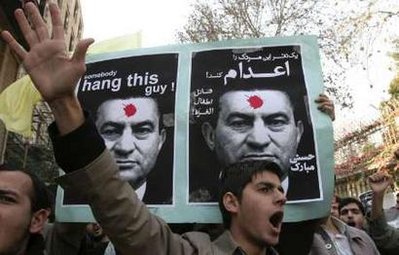
The revolution in Egypt never would have happened as fast and as ultimately peacefully as it did without the new digital age in full bloom. Now that Mubarak has resigned, the protesters are attempting to go back to life with an air of freedom conquering the stale odor of fear. Last night was one of jubilation as Egyptians of all stripes danced in the streets. The withdrawal of Mubarak was music in the ears. And, indeed, music was part of the process. Here is a hip-hop protest on Youtube with a range of video and still photographs by the Egyptian rap group known as Arabian Knightz. Other rap groups also found the recen protests worthy of Youtube. For yet another early video on the protests, click here. And here is a collage from the rapper Marcel Cartier.
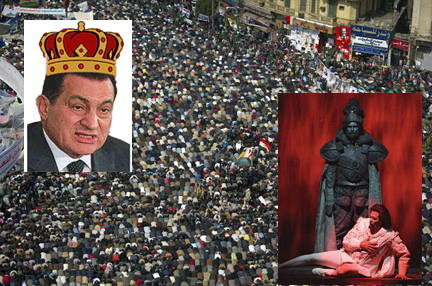
Eighteen days and no longer counting. On this day of farewell, although the wellness wished was not very strong for Hosni Mubarak among the thousands upon thousands of protesters gathered today in Tahrir Square, the Pharaoh left Thebes for good. There have been so many questions swirling in central Cairo and streaming into households worldwide that none of the thousands of pundit-pandered answers were able to satisfy. Never has a revolution been witnessed by so many people; never have so many questions been asked with so little ability to predict precisely what would happen. Will he leave? Or perhaps, more likely, when will he leave? Or, perhaps, has he already exited, stage right? Now we know, Mubarak has resigned.
Yesterday there was a brief spell of hope that Mubarak had finally accepted his fate. I attended an Egyptian event in Manhattan about as far away from the protests in Tahrir Square as can be imagined. This was a performance of Mozart arias translated into Arabic, some into Egyptian dialect. A friend arrived full of relief, having heard the earlier news that Mubarak was planning to leave. The old man’s long and self-serving speech seemed to squelch any hopes for that; the sighs and groans of the unified Egyptian spirit of protest could then be heard around the world. During intermission a long-time Egypt watcher told me that Mubarak will not leave and violence was sure to start up again. Thankfully, he was wrong. Continue reading Hosni Mubarak and Don Giovanni
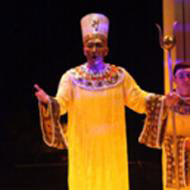
Ashraf Sewailam as Sarastro in Mozart’s “The Magic Flute,” Bibliotheca Alexandrina (Alexandria, Egypt), Jan. 2011
The New York Public Library for the Performing Arts, Dorothy and Lewis B. Cullman Center, Bruno Walter Auditorium at Lincoln Center is presenting a performance of scenes and arias from Mozart operas sung in Arabic by Mona Rafla, Cynthia Samaha-Melki, Ashraf Sewailam, and Raouf Zaidan, with pianist Mohamed Shams. Performances are Thursday, February 10, 2011 at 6 pm and Saturday, February 12, 2011 at 2:30 pm. For details see the website.
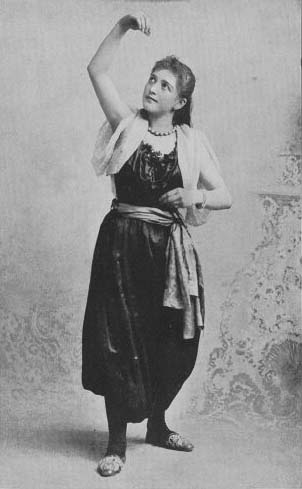
Little Egypt
There are several fascinating videos uploaded on Youtube of belly dance more than a century ago. One is a very short clip of 14 seconds from 1895 of a dancer named “Princess Ali.” Another is an early Edison film of Ella Lola, made in 1898, combined on Youtube with a 1900 track of Turkish music. The video lasts over three minutes. Ella was in costume, but another early video from 1904 shows “Princess Rajah” in the dress of the day dancing away her hoochie koochie as a circus act complete with chair. The queen of the art, at least in hindsight, was “Little Egypt,” who is also to be found in a clip from a movie about striptease. Although not an original film video, there is an interesting Youtube video with vintage “Orientalist” commentary about Egyptian and other North African belly dance at the 1889 L’Exposition Universelle, especially along “La Rue du Caire.”
For an overview of belly dance, see the excellent article by Najwa Adra.

Long before Lady Gaga or even Ella Fitzgerald there was the belle of Edison Record vaudeville. This was the warbler Ada Jones, who often sang duets with the indefatigable Billy Murray. One of her early songs, from 1909, was entitled “An Arab Love Song.” You can hear it on an original Gramophone on Youtube. A better recording is available here.
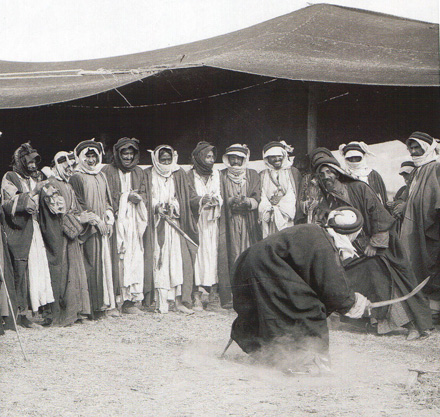
Sword dance at a Bedouin wedding in Palestine, early 1900s; Rowe 2010, opposite p. 116
We hear so much about the political turmoil between Palestinians and Israelis that the traditional culture and its transformation are all but forgotten. Bombs continue to go off or be dropped, settler slabs destabilize the opportunity for a variety of people to live together, hawks and doves flitter away in a rhetorical fog. Yet there is movement, especially in dance. Nicholas Rowe, a choreographer and dancer from Australia has recently published a moving portrait of the changing dance tradition among Palestinians, with a focus on how dance reflects political stalemate and obstacles. This is his Raising Dust: A Cultural History of Dance in Palestine (London: I. B. Tauris, 2010).
A brief description of the book is provided by the publisher: Continue reading Raising Dust in Palestine